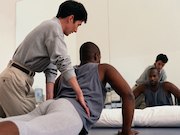Deep core muscle weakness linked to increase in peak anterior shear loading on all lumbar vertebrae
THURSDAY, Jan. 11, 2018 (HealthDay News) — In the presence of complete deep core muscle weakness, there is an increase in peak anterior shear loading on all lumbar vertebrae during running, according to a study published in the Jan. 23 issue of the Journal of Biomechanics.
Margaret E. Raabe, Ph.D., and Ajit M.W. Chaudhari, Ph.D., from The Ohio State University in Columbus, examined potential strategies used to compensate for weakness of the deep core musculature during running and noted associated changes in compressive and shear spinal loads. Simulations of over-ground running were created for eight healthy young adults at increasing levels of deep core muscle weakness. The deep core muscles were weakened individually and together.
The researchers found that for four out of five weakness conditions, the superficial longissimus thoracis was a significant compensator. When weakened individually, the deep erector spinae required the largest compensations (up to a 45 ± 10 percent increase in compensating muscle force production; P = 0.004), indicating that it may contribute most to controlling running kinetics. Peak anterior shear loading increased on all lumbar vertebrae with complete deep core muscle weakness (up to 19 percent; P = 0.001). In addition, there was an increase in compressive spinal loading on the upper lumbar vertebrae and a decrease on the lower lumbar vertebrae (up to 15 [P = 0.007] and 8 percent [P = 0.008], respectively).
“Insufficient strength of the deep core musculature may increase a runner’s risk of developing low back pain,” the authors write.
Copyright © 2018 HealthDay. All rights reserved.








